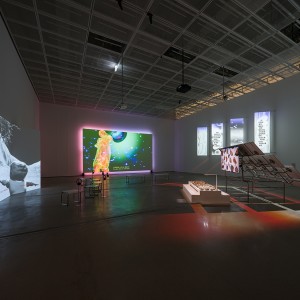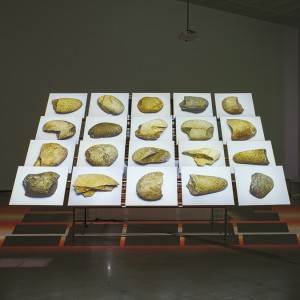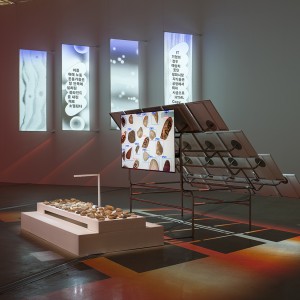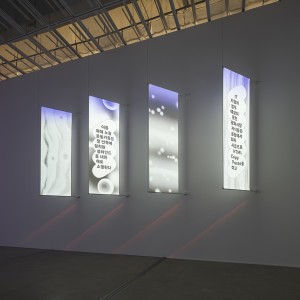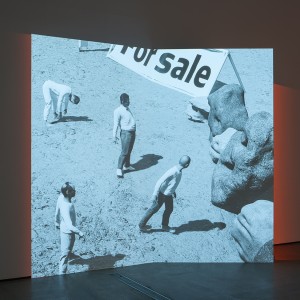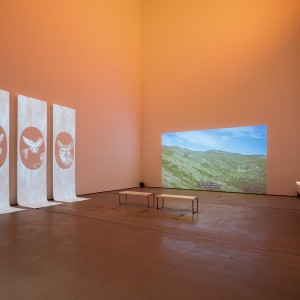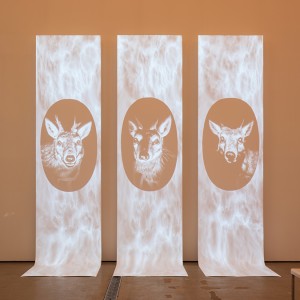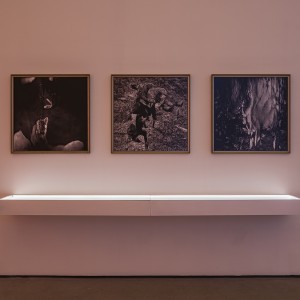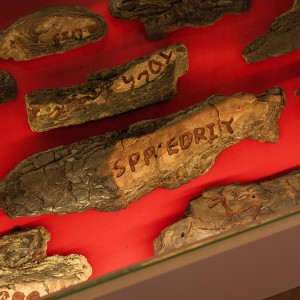Unmake Lab
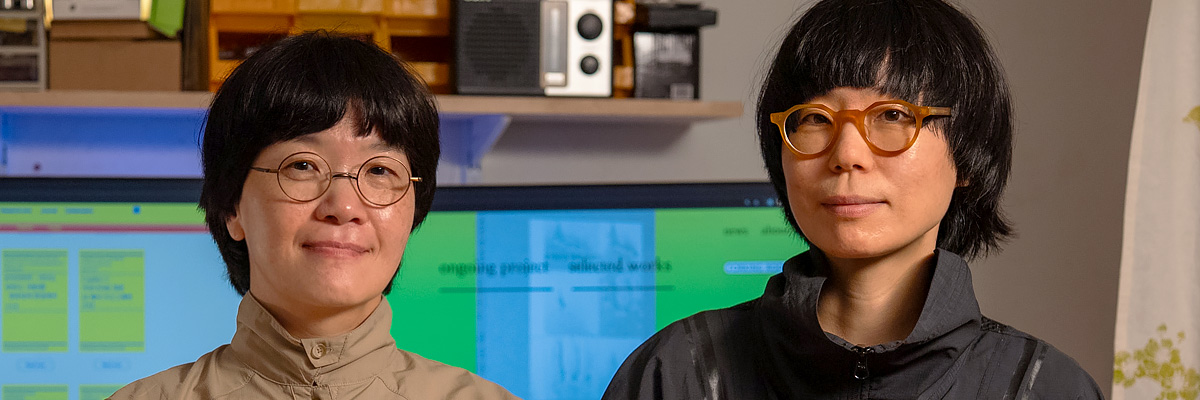
Interview
CV
Formed in 2016
Lives and works in Seoul
Selected Solo Exhibitions and Projects
2023
Popular Creatures, ARTSPACE BOAN 2, Seoul, Korea
2019
Operation Room, space imsi, Incheon, Korea
2018
Whole Data Catalog, Space 413, Seoul, Korea
2017–ongoing
Forking Room, Seoul, Korea
Selected Group Exhibitions and Screenings
2025
Korea Artist Prize 2025, National Museum of Modern and Contemporary Art, Seoul, Korea
When Spiders Spin Dusk, Coreana Museum of Art, Seoul, Korea
2024
ARE YOU FOR REAL Phase 2: Agents of Fluid Predictions (Online Screening)
Carnival of Shipwreck, The Bridge, Toronto, Canada
PANSORI, a Soundscape of the 21st Century, 15th Gwangju Biennale, Gwangju Biennale Exhibition Hall, Gwangju, Korea
What an Artificial World, National Museum of Modern and Contemporary Art, Cheongju, Korea
2023
Sorry, Frankenstein, Jeonbuk Museum of Art, Wanju, Korea
Nine Nodes of Non-Being, 421, Abu Dhabi, Arab Emirates
On Collecting Time, Nam June Paik Art Center, Yongin, Korea
2022
Mobile Scenarios for the Metamorphic Beings, Framer Framed, Amsterdam, The Netherlands
PLANT CITY, G Valley Industrial Museum, Seoul, Korea
Exceptional Times, Uncertain Moves, Seoul Museum of Art, Seoul, Korea
2021
Open Codes. Networked Commons, Nam June Paik Art Center, Yongin, Korea
The Pearl Diver, Gyeonggi Museum of Modern Art, Ansan, Korea
Digital Storytellers, Unfold X, DDP Design Museum, Seoul, Korea
Unreal World, space imsi, Incheon, Korea
2020
Tangible Error, d/p, Seoul, Korea
c-lab 4.0: UN+CONTACT, Coreana Museum of Art, Seoul, Korea
2019
Unlock, National Museum of Democracy and Human Rights, Seoul, Korea
The Security has been Improved, Coreana Museum of Art, Seoul, Korea
2018
The Dutch Savannah, Museum De Domijnen, Sittard, The Netherlands
Looms & Battles, Total Museum of Art, Seoul, Korea
2017
Futures of the Past, 2017 Gwangju Design Biennale, Gwangju Biennale Exhibition Hall, Gwangju, Korea
Future Base, Oil Tank Culture Park T1, Seoul, Korea
Immortal Makeshifts, Seoul Art Space Mullae, Seoul, Korea
Our Bright Future – Cybernetic Fantasy, Nam June Paik Art Center, Yongin, Korea
do it 2017, Seoul, Ilmin Museum of Art, Seoul, Korea
2016
Micro City Lab, Indie Art Hall Gong, Seoul, Korea
Selected Lectures and Workshops
2024
Gwangju Biennale Symposium, “Echoes of Tomorrow: Soundscapes in the Age of Advanced Computing,” National Asian Cultural Center, Gwangju, Korea
“Eco-logical Futures,” SNU Powerplant, Seoul, Korea
2023
“Decolonial Curatorial Agendas for a Green New Deal,” Art Sonje Center, Seoul, Korea
“Climate Future#2: Belonging and Shared Responsibilities,” NTU CCA, Singapore
“Disaster, Machine Learning, Dataset-ting,” National Asian Culture Center, Gwangju, Korea
International Symposium, “Circularity,” Seoul National University Museum of Art, Seoul, Korea
2022
Abnormal Behavior, Extinction, and Datasets, ADL, Seoul, Korea
“Disaster Haggyo,” KAIST Center for Anthropocene Studies, Daejeon, Korea
“Sentence Miner: Writing with AI,” Gyeonggi Cultural Arts Education Lab, Suwon, Korea
2021
“Tinkering with AI Datasets,” ieum Center, Seoul, Korea
2020
“Generic Nature, Slow Disaster: Life in the Age of Disaster,” KOTE, Seoul, Korea
“Teaching Game,” Art Collider Lab of Korea National University of Arts, Seoul, Korea
2019
“Label Me! : Data Pantomime,” Nam June Paik Art Center, Yongin, Korea
2017
“Data Crafting,” National Asian Cultural Center, Gwangju, Korea
“European Lab forum,” Les Subsistances, Lyon, France
Selected Grants
2023
Grant for Arts and Technology Convergence Support Program, Arts Council Korea, Korea
2022
Grant for Arts and Technology Convergence Support Program, Arts Council Korea, Korea
2020
Unfold X, Seoul Foundation for Arts and Culture, Korea
Selected Residencies
2024
MMCA Residency Changdong, Seoul, Korea
2020
Art Space Geumcheon, Seoul, Korea
Selected Publications
2024
Lee Kye Sung·Choi Binna. “Toy Models and Drunken Poets – GPT and Models of Generativity.” Forking Room Journal
2023
Kwak Youngbin·Yoon Wonhwa·Shim Hyowon, et al. Ecology in Latent Space: Disasters, Generative Neural Networks, and the Non-Futures. Seoul: Media Bus
Lee Kye Sung·Choi Binna. Context and Coincidence – GPT and Extractive Linguistics. Seoul: Media Bus
2021
Unmake Lab. Apophenia and the Sisyphus Dataset. Yongin: Nam June Paik Art Center
2017
Unmake Lab. Social and Cultural History of Kits. Seoul: Sewoon Labs
2015
Choi Binna. Generic Nature. Seoul: Mediabus
Selected Collections
Nam June Paik Art Center, Korea
Seo-Seoul Museum of Art, Korea
Critic 1
Laboratory for Unmaking
Yoon Wonhwa (Independent Researcher)
Artistic research unexpectedly reactivates the amateurism of modern art by defining artists not as production experts but as curious citizens who want to go outside and see the world with their own eyes to understand its mechanism.1 Becoming researchers, artists read books in a library, conduct research, and record their observations. Because they are researchers, they rely on the knowledge produced by academia; however, the fact that they are artists frees them from the constraints of formal systems of knowledge production and distribution. This does not imply that their knowledge production has a systematic flaw. Instead, it underscores that the purpose of their artistic research is not solely the production of knowledge. Artists tend to react sensitively to what has been omitted and altered in the process of knowledge production. They are attracted to the neglected miscellanea, to complex or highly specialized phenomena that resist theoretical abstraction, and to discarded remnants that are used to produce and apply knowledge. Artistic research detours from the standardized path of learning in which you need to know just enough, so you avoid what you don’t need to know and can’t know. It is an adventurous journey without a fixed destination.
When you ask what kind of artistic research Unmake Lab conducts, the answer is uncertain, but it is surely not research aimed at producing artwork or mounting exhibitions. The results of the research are presented in publications, but these do not present conclusive findings. Looking through Unmake Lab’s publications, such as Generic Nature (2015), which captures the landscape of Green Growth constructed by the National Four Major Rivers Project, and Ecology in Latent Space: Disasters, Generative Neural Networks, and the Non-Futures (2023), which traces the route of wildlife revealed by a forest fire and navigates synthetic image spaces where memory and speculation coexist, reveals that Unmake Lab’s research is like a travel diary that records intentional drift and unexpected encounters. The way the artists followed the process of destruction and reconstruction of human and non-human habitat resembles dark tourism, that is, the visitation of disaster sites. To add, Unmake Lab’s research sites include gentrified urban cities and newly built satellite cities. Sensing the absurdity in the seamless urban environment and perfectly planted parks and tracing its origin allows us to recognize the landscape as a widespread stratum of stacked, broken, scattered, and hardened time rather than a local space with a particular design and composition.
The transformation of contemporary landscapes is a byproduct of destructive innovation in which building and unbuilding form the two sides of a coin. The natural and the artificial and the constructive and the destructive are no longer differentiated. This situation dismantles the conventional idea of making, which humbly means touching and shaping materials and examining the outcome. From the daily act of preparing food to civil engineering that changes topology, our act of making is obscured by layers of extraction and fabrication of the resource, logistics, and the circulation of data. Unmake Lab’s interest lies in the ways we discover how that cruel, invisible, and yet omnipresent flow shapes our landscape and ourselves who are part of it, and, eventually, how we resist it. However, it is not Unmake Lab’s intention to redeem our creative activities from violence. Every making requires a moment of passing through suspicion. This thought is embedded in the duo’s name, Unmake Lab. To unmake something can be interpreted as to break, transform, or restore it: literally meaning to undo making. How can we resist the order of making, often seen as a magic wand for generating wealth? This is the question imposed by Unmake Lab.
Learning by Wrecking
“Unmaking” is not an intuitive word to understand, and it demands that we find a third way that does not belong to either making or not-making. As much as it sounds paradoxical, unmaking often takes place during the material-based practice of making. Imagine baking, only to produce a strange lump: part raw dough, part overbaked crust, part cookie, part charcoal. To fail in making is a segue to unmaking. Nonetheless, a faithful researcher of Unmake Lab would be unlikely to resign themselves to the obvious failure but instead would study it meticulously, using it as a source of fresh new information. You can learn something from failure—for example, you could use it as a guideline for better baking or to generate ideas of different things to make with the same flour. Many small studios turn damage into experimental textbooks for creative learning. “Reverse engineering,” that is, disassembling a machine without prior knowledge to learn the principles and design, is applied variously in ways that range from repairing and reproducing old things to analyzing market competitors. It recovers knowledge embedded in final products, reversing creation ends up leading to a new creation. In contrast, Unmake Lab examines sites of construction and destruction to reexamine the ideology and reality of creation.
What do we expect from “making” and can this expectation ever be fulfilled? Elaine Scarry proposes an interesting hypothesis that humans’ urge for making is connected to the moral desire to create a more humane world by reducing pain and overcoming biological limitations. In other words, making is inherently ethical. Nevertheless, making that betrays its righteous purpose has been repeated throughout our history. Making a killing weapon is an example. This is anti-social activity since the product isolates individuals, placing them in physical pain and disconnecting them from the world. Scarry says that every practice that produces a war machine, transforms everyday objects into tools of torture, and organizes humans and objects as elements of violence is more vicious than physical destruction because it is an “unmaking” that invalidates the essence of making by acting as its opposite. If making is defined as purpose-oriented, unmaking is considered an expression of immorality and stupidity. If the product of unmaking only increases others’ pain, it testifies to an inventor who cannot sympathize with others and does not realize the true meaning of making.2
To some extent, unmaking grows out of ignorance. However, no creation can receive a free pass from stupidity since outcomes often do not turn out as expected and cannot be controlled. Making is never a single, final act; rather, one object opens a latent space for other objects to emerge, and this consecutive emergence not only transforms the environment around us but also changes self-cognition and expectations. In a process of transformation and reinvention where causal relationships can not be fully determined, how do we reassess our goals and measure progress? Although Scarry investigates the dynamic of making from the humanistic perspective and tries to distinguish between moral making and its unethical retrogression, the human imagination—the source of creation—ultimately remains a mysterious and inhuman black box beyond rational understanding, touched by an almost sacred quality.3 What drives our relentless urge to make? Figuring out what we are making and what we reach after making is still a tricky puzzle. Our efforts to make a human-centered world give rise to innumerable blind spots both within and outside of ourselves. Even if we add more devices to identify and control situations, we see incompletely through the epistemological fog that never goes away, though it may be temporarily dispersed.
Unmake Lab emphasizes the educational value of unmaking as a reversal of humanistic and purpose-oriented making. It reminds us of our stupidity as incomplete makers and reveals the unacknowledged levels of the creative projects hidden in the orderly appearance of new products. Unmake Lab’s research process—tracing how constructive assignments unfolded in the name of progress and their results—inevitably leads to introspection on the innate destructiveness of human creation. Resources accumulated over eons—more neutrally speaking, planetary components formed at its own tempo and with a unique history—become artifacts with lifespans so short they disappear almost as soon as they appear from the geological perspective. However, on closer inspection, these materials haven’t simply vanished—they have been shifted, recombined, and reentered circulation. Unmake Lab follows living and nonliving things that are lost in a flow of fluidized materials and bears witness to how they reappear in new places. Creation and destruction are inseparable. That does not mean that nothing is lost, however. It means what passes through death reenters the living world in altered form.
Facing the Non-Future
The works of Unmake Lab multiply the landscapes of the nonfuture tense, which is distinctly different from saying that the future is disappearing. We speak in the future tense whenever we want. For example, looking at the scorched mountain, we discuss how to clean the remains and revive the vegetation, which is possible and desirable. Burnt bread is replaced with a new loaf; burnt forests, with replanting. However, from the future-oriented perspective, where the present is seen as the obstacle to the future, or no more than the previous phase, the forest fires are invisible, as if they should not exist, or have already been written out of the timeline. The frequent occurrence of mountain fires is like a short circuit caused by the long-term disturbance of the climate system and the instant malfunctions among humans and non-human beings; it is one of the most powerful examples of how destructive unmaking can be. We must face the site of failure before we hastily hide it under a futuristic blueprint. Unmake Lab’s research project, Ecology for the Non-Futures (2023), begins its journey at the burnt mountain, with its surreal landscape, and reveals a formerly unseen loose network of humans, plants, machines, and animals. This journey they take is not linear as it does not land in the future; in this sense, the journey is non-futuristic. Unmake Lab encounters the intertwined landscapes of present, future, and past, and takes a particularly close look at creative endeavors that will extend to the future.
Non-futuristic images both invite and reject futurity, and sometimes by their absence they testify to its impossibility. The trail cameras placed by environmental activists to monitor nocturnal animals’ habitats often capture no images. If a few animals are seen, they prove the animals are there, leading to optimism, but also to pessimism because this process is recording their disappearance. However, it is also a futuristic process because these images will be used as source materials to designate the protected area. Nonetheless, when these trail camera images are decontextualized and uploaded as the wildlife version of funny home videos on the internet, those animals, incarcerated in the frames, look immortal, nondecaying, and irretrievably absent at the same time. Unmake Lab sees no future in human-crafted nature images and “generic nature,” which is a material simulation of nature that once demolished and recomposed according to human desires.4 However, the artists still wonder what kind of future awaits us. They visit the natural history museums that exhibit the taxonomy of extinct animals and train generative artificial intelligence systems by feeding them information about disappearing species. In their practices, there is a haze of expectation that non-human beings might communicate with each other to make up unexpected stories even as humans create, select, and interpret the images as they wish. However, the laboriously gathered images of animals have been blurred like ghosts or algorithmically synthesized to form a pet-like facial expression that panders to our emotional expectation.
Images proliferate while there is the burnt mountain on which nothing is captured on the trail cameras. That the multiplied images function as unrealistic replacements to hide the absence of reality is nothing new. Neither is it new that the mountains are on fire and the animals are running farther away, while stereotypical nature images are on a loop. Non-futuristic images are on an ominous loop that is distinguished from the cycle of nature. The morning sun promises you the future, but its mechanical repetition feels inert like a broken machine—echoing Shumon Basar’s idea of the “endcore,”5 in which resignation, relief, and anticipation of the end are converged. The realtime disaster landscapes flood our screens without warning, shocking but familiar to us. They paralyze our sense organs and imagination like hot spices sprinkled on a plate of banal contents. Quoting Mark Fisher, Basar says that the endcore arises in voids in which hopes for the future fade and curiosity and desire for the present dissolve. Unmake Lab’s efforts to trace the non-linear time of the non-futuristic landscapes are attempts to overcome this decadence, yet the artists continually face dead ends on their journey.
Non-futuristic images interrupt the fantasy of escape and return the artists and the audience to the clueless present. Even if we cannot expect a clear vision of the future when all the problems are solved or eliminated, can we find a reassuring scene that differs from the non-futuristic images? In the introduction to one of their publications, Ecology in Latent Space: Disasters, Generative Neural Networks, and the Non-Futures, the artists write that they encountered a flock of Siberian teal on a winter evening when they walked from downtown to the shore.6 This species of bird is migratory, and they prepare for winter in Korea and Japan. Looking for food, they fly together in the evening. As the artists heard their loud calls and saw them flying overhead, they felt for a magical moment that everything was connected and gained a strong sense of the present. The phenomenal moment is not part of cyclical time, which follows the law of nature. Nor is it a pure stochastic pattern formed by the interactions of particles. It is a flash of serendipity that emerges from the patchwork of specific and local natures, both of which “guarantee an order that can be relied upon most of the time, [although] both can be occasionally disrupted by exceptions.”7 The Siberian teal cross the world built by humans.9 They attract bird watchers holding cameras, become the mascots of local festivals, spread bird influenza, get involved in plane accidents, and are ejected from photovoltaic generating facilities.8 There seems to be no definitive solution for either the humans or the birds, but the birds can still migrate. They seek new paths, new food sources, and extend their precarious present in every possible way.
Rearranging Humans
Yet where can humans migrate? Many philosophers have argued that instead of gazing at the sky, we must come down to the earth; that it is finally time to land on the earth to find ways to co-exist with the other inhabitants of this planet. This does not imply simple physical migration. It is an epistemological and thremmatological project that imposes on us to redefine the soil as a lively porous material and convert humans into components of the soil ecosystem. Like Donna Haraway’s insistence on composting humans in her speculative allegory, and Bruno Latour’s diplomatic suggestion to open a table for political negotiation by listing all the earth’s living residents and their habitats, this perspective demands the radical unmaking and reinvention of the world built by humans. One might imagine the Unmake Lab in the future establishing a sub-laboratory to study this new terraforming methodology. However, for now, its core research lies in the old terraforming system constructed and maintained by humans over the last several hundred years. The artists delve into the system and investigate the artificial topology where the residue of human dreams is sedimented, metamorphized, and erupted, as well as the ecology of synthetic beings.
Their interest in the fragments of civilization is based on the perception that the creator and the created are interchangeable, and that, to some extent, we are a by-product of our own creation. The question of what we have made so far is inseparable from the question of how we are made. We belong to nature, yet have the power to overcome it; we are a creator and creature of the modern industrial system. This multiplicity presents us with many possibilities, but it also leaves us disoriented, unsure of our current position or the direction we should take. Is the land below us? Or over us? More than thirty years ago, Rosalind Williams coined the idea of “subterranean consciousness,” an ecological awareness that we exist inside the earth, but was not specific about the time when we are or would be earth dwellers. Thus she wrote in paradoxically multiple tenses that “[h]uman beings have always been altering the face of the earth,” “preparing to descend below the surface of the earth forever,” and at the same time “have always lived below the surface.”10 This confusion derives from the refraction of our perception of reality by hopeful thinking, which occasionally leads to actual transformation. We create our reality based on our dreams. Doubting whether we have arrived at the destination or even departed, we descend into the abyss of the unknown, dreaming of heaven while still on earth.
Becoming a wise underground dweller is not easy. Before everything else, one longs for the “natural” sensation of hoping for tomorrow and looking up at the sky in open spaces on the earth. The underground world seems dark, stuffy, and sightless. Despite this, Unmake Lab finds a path in the cracks of the worldview generated by our blind creativity. These cracks from a journey that leads away from anthropocentricism wherein we are the center of creation, to enable examination of the various aspects of the dispersed and extended process of making. In this journey, Unmake Lab, wavers between tenuous optimism and persistent skepticism. Do the fantastic stories of wish fulfillment always end with the protagonists ruining themselves? It’s tempting to imagine a world without humans as a kind of ecological happy ending. However, it is more difficult to learn how to change course before the end or to imagine how we might live happily underground. We make a mess because we make a wish. The artists of Unmake Lab grope through the present refracted by imagined futures and forgotten pasts, propelled by a curiosity about what might be seen and how things might change when we accept the persistent limits of being human.
1. The figure of the “curious citizen” in this context draws from Charles Baudelaire’s portrayal of the anonymous newspaper illustrator “Monsieur G.,” whom he described as a model of the modern painter, not as an “artist” but as a “man of the world” (homme du monde). “When at last I ran him to earth, I saw at once that it was not precisely an artist, but rather a man of the world with whom I had to do. I ask you to understand the word artist in a very restricted sense, and man of the world in a very broad one. By the second I mean a man of the whole world, a man who understands the world and the mysterious and lawful reasons for all its uses; by the first, a specialist, a man wedded to his palette like the serf to the soil. Monsieur G. does not like to be called an artist. Is he not perhaps a little right? His interest is the whole world; he wants to know, understand and appreciate everything that happens on the surface of our globe.” Charles Baudelaire, The Painter of Modern Life and Other Essays, Trans. and ed. Jonathan Mayne (London: Phaidon Press, 1964), 6–7.
2. On the stupidity of unmaking, see Elaine Scarry, The Body in Pain: The Making and Unmaking of the World (Oxford: Oxford University Press, 1987), 278.
3. “The imagination works to distribute the facts and responsibilities of sentience out onto the external world; that the imagination tends to be ethically uniform on the issue of sentience; that the imagination is bound up with compassion; that the imagination has an inherent tendency toward largesse and excess; that the work of the imagination is not here and there, now on, now off, but massive, continuous, and ongoing, like a watchman patrolling the dikes of culture by day and by night; that the imagination forfeits its own immunity and is self-revising; and that, finally, the imagination is self-effacing, and often completes its work by disguising its own activity.” ibid., 325.
4. “Generic nature” is a neologism coined by Unmake Lab. “The title of this book is from the expression of ‘Generic City,’ coined by architect Rem Koolhaas indicating that a city is standardized and deprived of its local character. The conception is based on the generic naturalness whose source seems material but actually immaterial. It implies a record of the contemporary sense of nature consisting of urban planning and landscape planning, which present material blueprints of nature. Parks are equipped in cities as ‘small monumental areas’ decorated with landscaping stones and flowers. The techniques of various ecologization and restoration that nature cannot carry out by itself are also the techniques constructing ‘generic nature.’” Choi Binna, Generic Nature (Seoul: Mediabus, 2015), 18, the translation is partially revised.
5. Shumon Basar, “The Dawn of Endcore,” Flash Art 341, Winter 2022-23, https://flash—art.com/article/endcore/.
6. Unmake Lab, “Introduction: Interpolation Between the Computational Singularity and Non-human living things,” in Ecology in Latent Space: Disasters, Generative Neural Networks, and the Non-Futures [in Korean] (Seoul: Mediabus, 2023), 5.
7. “The most ancient and still most prevalent colloquial sense of nature, the original meaning of both the ancient Greek word ‘physis’ and the Latin ‘natura,’ is ‘specific nature’: that which makes something unmistakably what it is, and not something else. It is [...] shared characteristics that imprint a natural kind with predictable properties. Specific natures make classification of both the animate and inanimate world possible, whether in the form of the periodic table of elements or Linnaean taxonomy. Almost as ancient are local natures, the configuration of flora and fauna, geography and topography, weather and climate that create distinctive landscapes and biotopes. [...] The orders of both specific and local natures account for stable regularities that are at least as pervasive and consequential as laws of nature like those of Descartes. However, neither specific nor local natures achieve anything like the generality, simplicity, or immutability of laws of nature. [...] [A]lthough both guarantee an order that can be relied upon most of the time, both can be occasionally disrupted by exceptions. Every now and then the swallows may not return in spring or wind-driven water may run uphill; the monsoon rains may fail or Siberian temperatures soar.” Lorraine Daston, Rules: A Short History of What We Live By (New Jersey: Princeton University Press, 2022), 227–228.
8. “Jeju Air Accident: The Feathers of a Siberian Teal Were Found, but the Experts Say ‘It Will Take Over a Year to Conclude,’” JoongAng Ilbo News, Jan. 26, 2025; “Where Did All Those Siberian Teal Go,” Hankook Ilbo News, Feb. 16, 2023; “The Unfortunate Story of Siberian Teal Being Blamed for the Bird Influenza,” Hankook Ilbo News, Jan. 11, 2017; “Where Did Tens of Thousands of Siberian Teal who Displayed Murmuration Go?,” The Hankyoreh News, Dec. 21, 2012.
9. Donna Jeanne Haraway, Staying with the Trouble: Making Kin in the Chthulucene (North Carolina: Duke Press, 2016); Bruno Latour, Down to Earth: Politics in the New Climatic Regime (Cambridge: Polity Press, 2018).
10. Rosalind Williams, Notes on the Underground: An Essay on Technology, Society, and the Imagination (Cambridge, London: MIT Press, 2008), 212–213, 273–274.
Critic 2
The Future of Delta Tomatoes
Lee Kye Sung (Independent Researcher in Media)
The following essay was co-written by the author and OpenAI o3, drawing on working notes and a script provided by Unmake Lab. Texts written by the author are set in regular type, while those generated by the language model are underlined. The text was first written in English and then translated into Korean.
“If I had to choose the most idiosyncratic crop in Korea, grown in its unique soil formed by natural phenomena, I would undoubtedly point to Daejeo Salty Tomatoes. The unique climate of the Daejeo region transforms the ordinary tomato we often eat into a completely different kind. In France, the unique climate of each region that affects the cultivation of a crop is called ‘terroir,’ and they value the preservation and management of the characteristics of the terroir that give the crop its character. Terroir is responsible for the singular characteristics of wines from different regions of France, and for maintaining these diverse characteristics. The Daejeo region has a distinctive terroir, which is why Daejeo Salty Tomatoes not only taste different, but also look different, so much so that it is hard to say they are the same variety as regular tomatoes. They differ in size and colour. Cultivation methods do differ, but ultimately it comes down to the magic of terroir.” ― Moon Jeong-hoon, “The Future of Daejeo Salty Tomatoes” [in Korean], Hankook Ilbo, May 10, 2019.
Daejeo Tomato
Eco Delta Smart Village, the setting for Unmake Lab’s New-Village (2025), is located in Eco Delta City, a new town that encompasses Gangdong-dong, Myeongji-dong, and Daejeo-dong in Gangseo-gu, Busan. While Myeongji-dong, where the Smart Village is situated, is famous for its leeks, neighbouring Daejeo-dong has become known for its tomatoes. Tomatoes from this area, also known as “Salty Tomatoes,” are reported to have hit record sales last year, which is unusual given that concerns have been raised for several years about the potential disappearance of most tomato growing areas due to the Eco Delta City development project. New-Village weaves a fictional story into this real-life backdrop. The story revolves around the “Delta Family,” a family of four who won their place in the Smart Village through a highly competitive lottery, and the “Delta Tomatoes,” which have been artificially enhanced and mutated into different forms.
As its name suggests, Eco Delta City is located within the Nakdong River delta, where the river meets the South Sea. The area’s agricultural history dates back to the construction of Korea’s first estuary gates in the 1930s. These gates were designed to prevent seawater from flowing back through the Noksan Gate in the south, while allowing freshwater to pass through the Daejeo Gate in the north. This enabled the West Nakdong River to be used for agriculture while mitigating the risk of flooding. At the same time, land reclamation projects consolidated many of the delta’s islands into larger land masses to secure arable land. Although seawater from the South Sea is widely believed to give Daejeo Salty Tomatoes their distinctive taste, those with even the slightest interest in the region’s history know that the soil is the product of human engineering rather than a gift from nature.
Nevertheless, a romanticised narrative persists. The above quoted Hankook Ilbo article echoes this idea, describing Daejeo Tomatoes as “the most idiosyncratic crop in Korea, grown in soil formed by natural phenomena,” and attributing their flavour to “the magic of terroir.” In reality, however, the success of Daejeo Tomatoes owes as much to colonial-era reclamation projects as it does to varieties like “Tosama” and “Super Sun Road” from Japan’s Sakata Seed Corporation. These varieties proved especially successful when introduced in the 2000s, thanks to their strong roots and efficient nutrient uptake, helping them to thrive in saline soil. Media coverage and strategic branding soon followed, cementing the Daejeo Salty Tomato’s status as a regional specialty. Ultimately, Daejeo tomatoes are as much the result of agro-technological intervention and branding as they are of saline soil.
Delta Tomato
In Unmake Lab’s work, ecology never appears as a natural whole. Rather, it is always already interwoven with contemporary systems of optimisation, with the Delta Tomato being the latest example of this view (Unmake Lab sees tomatoes as the most neoliberalised crop). Recognising this messy entanglement means acknowledging the limitations of any politics that pits nature against technology.
The Delta Tomato, which we might envision as a possible future manifestation of the Daejeo Salty Tomato, appears in many different iterations throughout the work. It gets transformed into a hyper-cultivated variety called the “Big Beef Tomato”; it lends its name to the Smart Village’s T.O.M.A.T.O (Total Observation and Management of Abnormal Trends and Operations) surveillance system; or it evolves into the “Blue Tomato” that causes nausea and strange dreams when consumed by humans. The unidirectional techno-futurism of the Smart Village shapes the Delta Family as much as it shapes the Delta Tomatoes.
The Delta Tomato is less a botanical curiosity than an index of algorithmic selection pressure: a phenotype sculpted by predictive modelling, yield-forecast dashboards, and sensor-derived nutrient recipes. Read this way, the fruit operates as the visible remainder of an invisible optimisation loop—each wrinkle in its epidermis a data point, each sugar—acid ratio a negotiation between cloud-based agronomics and shareholder futures. Such framing refracts the conventional terroir discourse through the logic of platform capitalism, suggesting that the real soil of the Eco Delta City today may be a stack of APIs and spreadsheets rather than the silt of the Nakdong River delta.
The glossy surface of the Delta Tomato occludes a choreography of human labour routed through algorithmic command. Greenhouse pickers wear wristbands that vibrate when realtime demand in Seoul’s premium groceries spikes; truck routes are auto-reoptimised, often extending shifts beyond contractual limits in order to shave minutes off delivery. In this configuration, optimisation does not replace labour but re-tempos it, synchronising bodies to the cadence of commodity circulation rather than to circadian or seasonal rhythms. The tomato thus embodies what Anna Lowenhaupt Tsing names “supply-chain capitalism,” in which biological ripeness is secondary to logistical pliability. Examining its flavour profile without tracing these labouring rhythms risks mistaking an artefact of acceleration for terroir.
Recent walkouts over unpredictable shift extensions introduced an unplanned twenty-four-hour hiatus in supply, during which Seoul retailers displayed placards explaining the absence of Delta Tomatoes as a “climate-related shortage.” The misattribution is telling: labour refusal is rendered invisible within the optimisation narrative, recoded as ecological anomaly. Yet this friction momentarily dislocated the cadence of supply-chain capitalism, reminding us that the tomato’s logistical smoothness is contingent, not inevitable, and that temporal sovereignty remains a site of contestation within the algorithmic greenhouse.
Cybernetic Terroir
It is important to point out that terroir itself is also a political construct, not a natural given. Long before it was printed on wine labels the term circulated in debates about French regional identity. According to Thomas Parker, a French literature scholar who has meticulously traced the evolution of the concept of terroir, it was these debates that culminated in the early-twentieth-century appellation d’origine contrôlée AOC laws that legally fixed taste to place.
In the sixteenth century, Michel de Montaigne saw terroir through an anthropological lens, as a continuous flow between place and person. He likened humans to plants, arguing that soil and climate shaped bodies and morals alike; he therefore praised the inhabitants of the New World for retaining an unfiltered primal integrity. In contrast, his contemporary Jean Bodin cautioned that excessive attachment to locality could cause communities to become unruly and endanger civic order. These two opposing views highlighted the tension between plural ecologies and central authority. This tension intensified in the mid-seventeenth century, when the newly established Académie française sought to standardise pronunciation and vocabulary. Anything that “smelled of terroir”—accents, manners, as well as cuisine—was stigmatised as rustic impurity. However, by the late Enlightenment, provincial intellectuals inverted the slur, casting terroir as proof of France’s biodiversity. Terroir was thus rehabilitated and folded into a new culinary patriotism. It was this kind of thinking, combined with anxieties about a globalised market and the influx of cheap imports, such as Algerian wine, that led to the creation of the AOC system in the early twentieth century.
If the AOC once anchored Frenchness in limestone and loam, New-Village suggests that the Smart Village roots identity in a continuously updated dataset: salinity probes, SAP dashboards, drone-borne chlorophyll indices. Terroir here becomes a cybernetic regime of governance—one that calibrates not only tomato morphology but the very eligibility of Smart Village residents, whose biometric and consumption metrics are folded into the same optimisation cloud. The fruit’s “local flavour,” in other words, is secured less by geology than by a permissions architecture that decides which variables may circulate and which must remain firewalled.
Extending the logic of terroir as cybernetic governance, New-Village intimates that optimisation protocols do not stop at the greenhouse door: residency in the Smart Village itself is tiered by the same metrics that grade tomato skin tension. Credit scores, carbon footprints, even how often inhabitants recycle cooking oil—each variable is folded into a composite terroir-index that brokers access to schooling, healthcare, and bandwidth. In this schema the tomato’s calibrated sweetness mirrors a parallel calibration of citizen-subjectivity, revealing a shared substrate where data agronomy and social engineering co-produce locality.
Algorithmic Nonduality
A similar protectionist impulse also surfaced in Japan and later in Korea through slogans such as “the nonduality of body and soil 身土不二.” Although its use has declined somewhat in recent years, it remains common in the branding of various agricultural products, at least in Korea. This concept, which is widely understood to mean that food produced in Korea is best for Koreans, originally derives from the Buddhist concept of “nonduality 不二,” which means that although the physical body and the earth may appear to be opposites, they are fundamentally one and should not be artificially separated. The terminology appears in texts from the Northern Song dynasty, but its modern iteration emerged in Japan following the Meiji Restoration—a period of rapid Westernisation that altered diets and undermined demand in native crops. Military physician Ishizuka Sagen advocated an overhaul of food culture by eating produce from the local climate, and in 1912, one of his disciples appropriated the concept of the nonduality of soil and body from its Buddhist context and used it to defend domestic agriculture.
South Korea adopted the slogan under comparable pressure some seven decades later. During the Uruguay Round negotiations (1986–1994) Seoul was pressured to open its rice market. This was a time when South Korean agriculture, accustomed to self-sufficiency, began to confront the global trading order in earnest. Seeking a rhetorical shield for farmers, Han Ho-seon—then head of the National Agricultural Cooperative Federation—encountered the concept in a Japanese agronomy book he was translating and launched it as a nationwide branding campaign in 1989. By 1993, the slogan had entered pop culture via the eponymous hit single by the singer Bae Il-ho, embedding the idea that Korean soil best nourishes Korean bodies.
Within New-Village, the Buddhist tenet that “body and soil are undivided” is re-ciphered as a data axiom: wearables stream resident glucose levels to the same cloud that tracks greenhouse osmolarity, stitching metabolic and pedological readings into a single optimisation graph. The Smart Village thus literalises the nonduality of soil and body by folding bodily homeostasis and soil chemistry into one continuous feedback loop—an intimacy that masks, yet reproduces, the protectionist logic of keeping value-added biopixels inside municipal firewalls. Again, we have a cybernetic vision of nonduality at play. But what happens when there is a glitch in this feedback loop of soil and body?
Blue Tomato
The Blue Tomato enters New-Village as the manifestation of this glitch: a phenotypic anomaly the optimisation system cannot parse. A chemical imbalance in the tomatoes, triggered by an unforeseen drop in temperature, inverts the ripening spectrum from red to blue; yet the neural network continues to flag the fruit as “ripening soon.” This mismatch exposes the limits of algorithmic nonduality of soil and body, revealing how the promised continuum between metabolic and pedological data collapses when an out-of-distribution variable—temperature drift, server lag—propagates through the loop. The result is a feedback choke where body and soil remain entangled, but now in shared nausea rather than shared nourishment.
Once the algorithm misclassifies cobalt as crimson-in-waiting, its downstream logics—nutrient pumps, retail forecasts, even recipe suggestions on residents’ smart fridges—inherit the error. Fertiliser valves over-dispense potassium, supermarket shelves overstock salsa kits, and diet-tracking apps applaud users for an antioxidant intake that in fact induces queasiness. The single blue glitch thus multiplies into a polyphonic malfunction, showing how tightly coupled algorithmic nonduality becomes a resonant chamber where a local perturbation reverberates across ecological, economic, and metabolic registers.
Chromatically, Blue Tomatoes unsettle an entire semiotic economy premised on red as edible, ripe, safe. The neural net’s failure to segregate hue from maturity underscores a deeper epistemic blind spot: optimisation engines have difficulties in ingesting patterns they have not seen. The Blue Tomatoes therefore exist in the zone of the incomputable—a space between training data and unmodelled climate volatility, insisting on a category beyond the archive of past observations.
If optimisation aspires to a sealed ontology, the Blue Tomato exemplifies ontological leakage: a seepage of material reality beyond the schema. The fruit forces a tacit admission that the archive of past observations—what machine learning calls the training set—cannot circumscribe future materialities shaped by climate volatility and biochemical drift.
It might be tempting here to read the incomputability of the Blue Tomato as a glitch that resists the Smart Village’s optimisation grid. The incomputable may indeed refer to an ungraspable outside that resists computational capture. It may also enable opacity in Édouard Glissant’s sense—an irreducible remainder resistant to tabulation. However, this outside or opacity can also obfuscate responsibility: the toxins are absorbed by human stomachs while the optimisation grid remains unchanged, still classifying the tomatoes as “ripening soon.” Moreover, the fruit’s emergence is rooted in the abnormal temperatures that the Smart Village itself helps to intensify. The Blue Tomato thus dramatises incomputability as a pharmakon, opening a sliver of indeterminacy while concealing the connection to the climatic violence that produced it, as well as any other accountability.
Overcoming Technology
The toxicity of technics has long tempted thinkers to seek redemption in an imagined outside. Such a longing animated Martin Heidegger and his student Nishitani Keiji in the 1930s, when both diagnosed modern technoscience as nihilistic and proposed to overcome it by reviving primordial bonds between soil and body. Their programme, however, slid towards fascist traditionalism, demonstrating how the quest for an outside to technology can reinforce new modes of domination.
It is worth noting how Nishitani Keiji, the Kyoto-school philosopher steeped in Buddhist thought, also employed the concept of the nonduality of soil and body in its modern ethno-nationalistic iteration. By doing so, he inadvertently revealed its political implications. While studying with Heidegger in Freiburg during the late 1930s, Nishitani attended a meal cooked by a fellow Japanese student who had brought rice all the way from Japan. Having lived on Saxon cuisine for some time, Nishitani tasted the rice from his homeland and had an ontological experience, which he later recalled as follows:
“This same experience also made me think about what is called homeland, which is fundamentally that of the inseparable relation between the soil and the human being, in particular the human being as a body. It is “the nonduality of soil and body” of which Buddhism speaks. In my case, homeland is the “Land of Vigorous Rice Plants”: a soil fit for rice and a people that has found the mainstay of its livelihood in rice cultivation. From generation to generation, my ancestors have had rice as their staple food. The special ingredients of the land called Japan are transferred to the special ingredients of the rice called “Japanese rice” and through eating rice, they are transferred to the blood of our ancestors, and that blood flows through my body. Perhaps from long ago, the vital connection between the countless people who were my ancestors, the rice, and the land has always been the background of my life and is actually contained in it. This experience made me remember something that I had usually forgotten.”
For Nishitani, this epiphany crystallised the ethno-nationalistic principle of the nonduality of soil and body and fed directly into his later role in Japan’s wartime “Overcoming Modernity” movement—a project that sought to outflank Western technoscience through a return to an idealised cultural essence.
His teacher Heidegger pursued a parallel escape route. While Nishitani appealed to Buddhist emptiness 空 as communal ground, Heidegger looked to pre-Socratic Greece to remedy Europe’s forgetfulness of being. Both treated technology as a metaphysical event that locks time into a single eschatological vector; and both flirted with fascism as political expressions of their nostalgia. The philosopher of technology Yuk Hui calls this stance “metaphysical fascism”—a backlash against modernity that opposes universal technics with a supposedly natural past.
For Heidegger and Nishitani, nihilism named the vacuum produced when the world is grasped solely as an object for representation and extraction. While this nihility grew gradually in Europe with the Scientific Revolution, it arrived abruptly in East Asia when gunboats forced open ports, and it continues to this day in the form of GDP-centred extractivism. Although their proposed cures differ, both aimed to heal the temporal rift by outflanking technics through a naturalised tradition. The fact that fascism named their outside to modern technology, when considered alongside the climate-induced incomputability of the mutant Blue Tomato, demonstrates that not all attempts to overcome technology are necessarily laudable.
Eschatological Future
Even though Heidegger and Nishitani represent two reactionary answers to modern nihilism from the early twentieth century, Hui devotes much attention to them in The Question Concerning Technology in China (2016) and Post-Europe (2024). Heidegger is seen as the thinker who first posed the question of technology in metaphysical terms in relation to time, while Nishitani is regarded as the first East Asian thinker to engage with technology in the same vein. But what exactly does he mean by “time” in this context? To oversimplify, it is the eschatological, unidirectional temporality that accompanies the objectification of the world. The tendency to objectify, mathematically represent, and extract value from the world tends to lead to a dead end, whether that be the technological singularity that has been much discussed, or all out extinction.
Hui’s concept of cosmotechnics is a way of acknowledging technology as the root cause of this unidirectional temporality, with the aim of enabling multiple temporalities through constructing diverse conceptions of technology shaped by the worldviews of different localities. When viewed through this lens, New-Village appears not only as a local fable, but also as a contemporary node in a long-standing dispute over technics and time.
The Smart Village in New-Village serves as a stage on which futures are continuously predicted, optimised, and therefore narrowed. Dashboards, sensors, and neural nets compress futurity into a perpetually refreshed present, narrowing what may come. In this way, the Smart Village beta-tests an optimised future community. Endless prediction of the future, based on thorough data collection, is the function of this village. This is what the Delta Family, wittingly or unwittingly, signed up for when they applied for the lottery to win a home here. Imagine how happy they must have been when they were chosen. What they may not have known was that they would become mere data points in this system—a fate that would manifest itself as their neurosis. Is there any hope for the Delta Family? Is there a way out of this eschatological nihility that does not involve retreating to an idealised version of nature or tradition?
Pharmakonic Futures
By now, we have seen just how artificial the supposed “magic of terroir” really is: how factors such as colonial reclamation projects, optimisation dashboards, and labour logistics create the flavour that is sold as natural. However, simply entangling terroir with code may not be sufficient. When the optimisation loop falters—as signalled by the Blue Tomato glitch—the pastoral romance collapses into nausea and terroir becomes a site of toxic feedback rather than natural locality. Perhaps, then, the real “magic” lies not in the taste itself, but in the uneasy reminder that any sweetness can turn into a toxin overnight.
The hallucinations induced by the Blue Tomato fold future ruins into present sleep, suspending Smart Village time between predictive dashboards and prophetic dreams. This latency realises the nonduality of soil and body, but in negative: the land now speaks through nausea. But the toxins of the Blue Tomato also point to the possibility of a different future.
While the Blue Tomato is a glitch that evades the capture of the tomato neural net, this is far from the emancipatory space of potentialities often portrayed in contemporary media theory, as we noted above. Nevertheless, it is hard not to see its toxins as being pharmakonic in nature. If Delta Tomatoes can develop toxins that induce nausea and hallucinations in humans, might they also develop chemical compounds that could act as potential cures?
Yet the very question—might the Delta Tomatoes strain mutate toward medicinal benevolence?—already betrays a residual utilitarianism the pharmakon obliges us to suspend. Jacques Derrida reminds us that a pharmakon is neither substance-A (poison) nor substance-B (remedy) but a differential interval whose valence materialises only within a given economy of care and interpretation. What matters, then, is not the chemical payload of an eventual crimson-or-cobalt fruit but the regimes of anticipation, extraction, and governance that pre-assign it a position on the axis of harm or benefit. To leap from toxin to cure is to preserve, unchanged, the optimisation telos that produced the glitch in the first place—merely flipping its sign while leaving the calculus intact.
Bernard Stiegler’s pharmacology helps us keep the double edge in view. For him every technical supplement both extends and destabilises human individuation; the task is not to eradicate toxicity but to critically engage with it through practices of what he calls soin (care). The Blue Tomato’s errant metabolism therefore cannot be welcomed as a disruptive glitch so much as confronted as a symptom—one precipitated by the very abnormal temperatures that the optimisation cloud failed to foresee. In this light, talk of “redesigning” the agro-algorithmic loop must not imply repurposing the toxin, but rather interrogating the temporal compressions and exclusionary metrics that rendered volatility invisible. Any loosening of feedback speeds or pluralisation of traits is worth pursuing only insofar as it foregrounds ecological precarity and distributes the power to counter extraction.
Viewed this way, the toxin becomes signal rather than resource. Its nausea marks the threshold at which algorithmic nonduality ossifies into coercive sameness, and therefore the point where an otherwise can be imagined—not predicated on scavenging value from failure, but on recalibrating the temporalities through which soil, body, and data co-evolve. The more generative horizon lies in treating the breakdown as a prompt to rethink tempo, participation, and value in cultivation practices. On that horizon, a future Delta Tomato could flourish—not as miracle cure, but as evidence that agriculture can proceed without compressing every uncertainty into commodity form.

